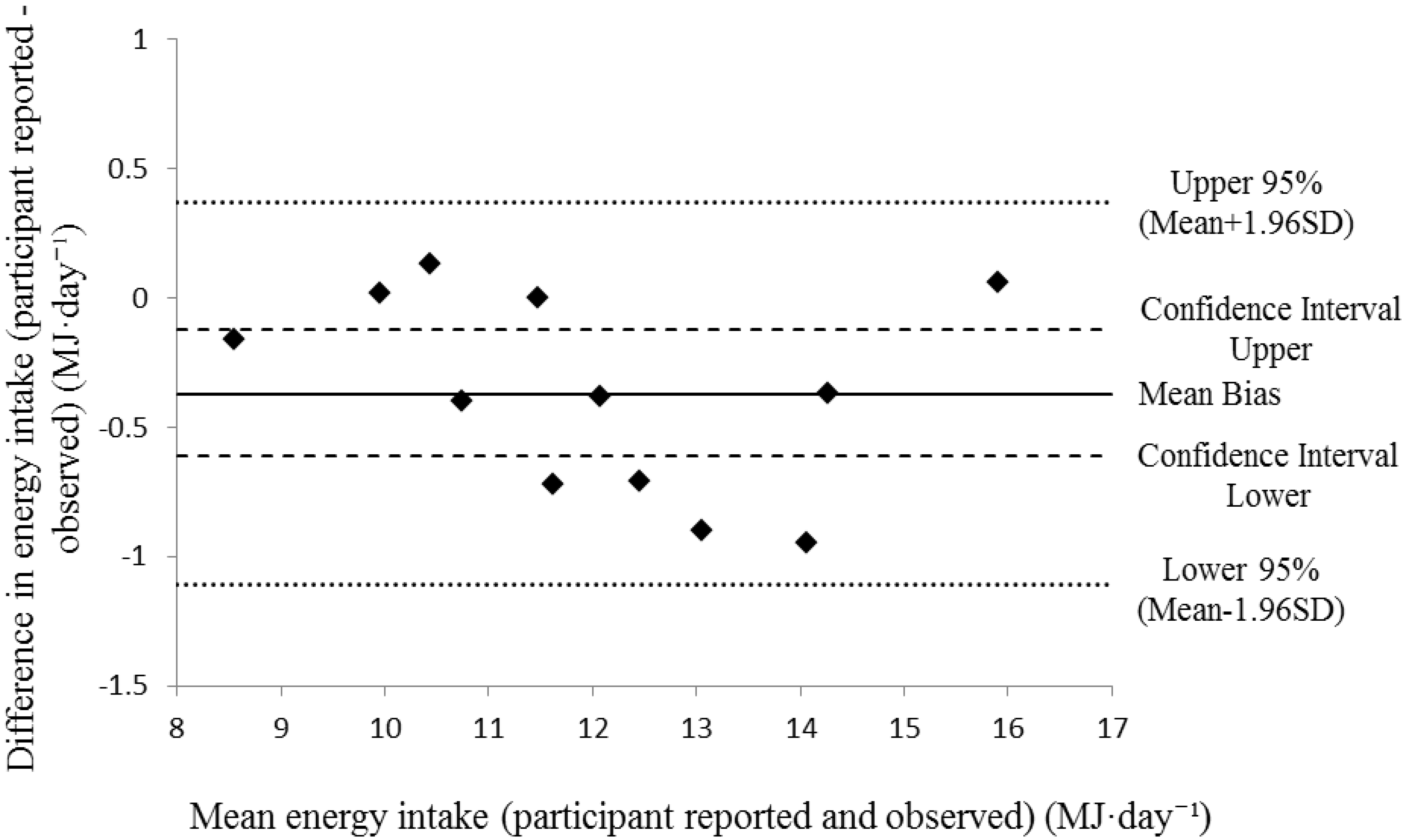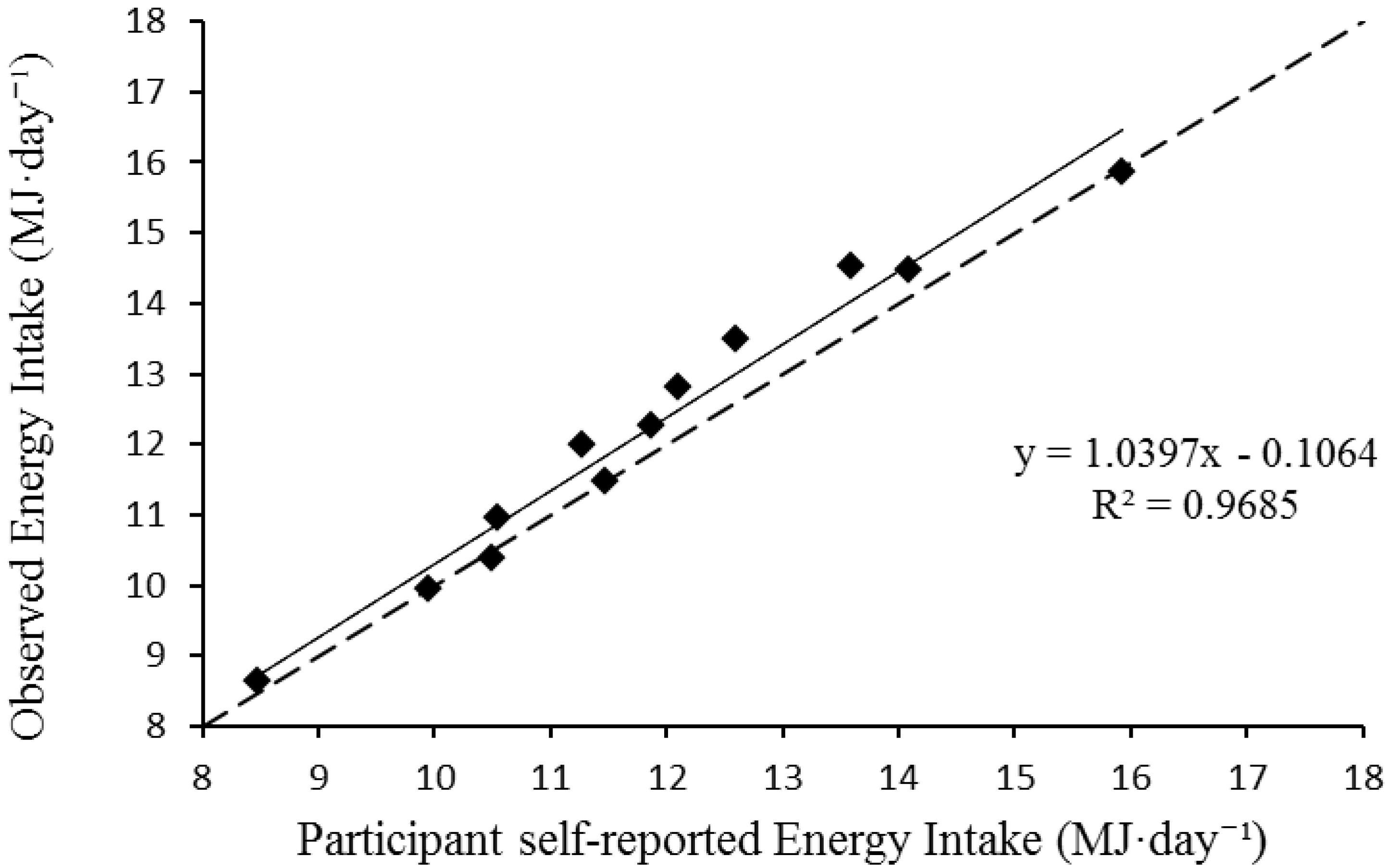Agreement between Two Methods of Dietary Data Collection in Male Adolescent Academy-Level Soccer Players
Abstract
:1. Introduction
2. Experimental Section
2.1. Design
2.2. Participants
2.3. Protocol
| Meal | Food and Drink Items Available |
|---|---|
| Breakfast | Kellogg’s Frosties, Coco pops, Cornflakes, Honey loops, Coco “Choc n Roll”, Rice Krispies Multi-Grain, Rice Krispies, Weetabix, semi-skimmed or whole milk |
| Lunch | Ham Sandwich white/brown bread with/without butter, Chicken Sandwich white/brown bread with/without butter |
| Dinner | Jacket potato (with/without beans, cheese), Tomato pasta (with/without cheese), Chicken breast (with/without potatoes, carrots, tomato sauce) |
| Secondary Items | Orange cordial (no added sugar), water, pure apple juice, pure orange juice, fruit (bananas, apples, clementines), yoghurts, cereal bars, crisps, confectionary |
2.4. Estimation of Energy Intake
2.5. Analysis
3. Results


4. Discussion
5. Conclusions
Acknowledgments
Author Contributions
Conflicts of Interest
References
- Meyer, F.; O’Conner, H.; Shirreffs, S.M. Nutrition for the young athlete. J. Sport Sci. 2007, 25, 73–82. [Google Scholar] [CrossRef] [PubMed]
- Mielgo-Ayuso, J.; Maroto-Sánchez, B.; Luzardo-Socorro, R.; Palacios, G.; Palacios Gil-Antuñano, N.; González-Gross, M. Evaluation of nutritional status and energy expenditure in athletes. Nutr. Hosp. 2015, 31 (Suppl. 3), 227–236. [Google Scholar] [PubMed]
- Bass, S.; Inge, K. Nutrition for special populations: Children and young athletes. In Clinical Sports Nutrition; Burke, L.M., Deakin, V., Eds.; McGraw-Hill: Sydney, NSW, Australia, 2006; pp. 589–632. [Google Scholar]
- Livingstone, M.B.; Robson, P.J.; Wallace, J.M. Issues in dietary intake assessment of children and adolescents. Br. J. Nutr. 2004, 92 (Suppl. 2), S213–S222. [Google Scholar] [CrossRef] [PubMed]
- Hill, R.J.; Davies, P.S.W. The validity of self-reported energy intakes as determined using the doubly labelled water technique. Br. J. Nutr. 2001, 85, 415–430. [Google Scholar] [CrossRef] [PubMed]
- Livingstone, M.B.E.; Prentice, A.M.; Coward, W.A.; Strain, J.J.; Black, A.E.; Davies, P.S.W.; Stewart, C.M.; McKenna, P.G.; Whitehead, R.G. Validation of estimates of energy intake by weighed dietary record and diet history in children and adolescents. Am. J. Clin. Nutr. 1992, 56, 29–35. [Google Scholar] [PubMed]
- Bandini, L.G.; Cyr, H.; Must, A.; Dietz, W.H. Validity of reported energy intake in preadolescent girls. Am. J. Clin. Nutr. 1997, 65, 1138S–1141S. [Google Scholar] [PubMed]
- Champagne, C.M.; DeLany, J.P.; Harsha, D.W.; Bray, G.A. Underreporting of energy intake in biracial children as verified by doubly labeled water. J. Am. Diet. Assoc. 1996, 96, 707–709. [Google Scholar] [CrossRef]
- Champagne, C.M.; Baker, N.B.; DeLany, J.P.; Harsha, D.W.; Bray, G.A. Assessment of energy intake underreporting by doubly labeled water and observations on reported nutrient intakes in children. J. Am. Diet. Assoc. 1998, 98, 426–433. [Google Scholar] [CrossRef]
- Bandini, L.G.; Schoeller, D.A.; Cyr, H.N.; Dietz, W.H. Validity of reported energy intake in obese and non-obese adolescents. Am. J. Clin. Nutr. 1990, 52, 421–425. [Google Scholar] [PubMed]
- Bratteby, L.-E.; Sandhagen, B.; Fan, H.; Enghardt, H.; Samuelson, G. Total energy expenditure and physical activity as assessed by the doubly labelled water method in Swedish adolescents in whom energy intake was underestimated by 7-d diet records. Am. J. Clin. Nutr. 1998, 67, 905–911. [Google Scholar] [PubMed]
- Bandini, L.G.; Must, A.; Cyr, H.; Anderson, S.E.; Spadano, J.L.; Dietz, W.H. Longitudinal changes in the accuracy of reported energy intake in girls 10–15 y of age. Am. J. Clin. Nutr. 2003, 78, 480–484. [Google Scholar] [PubMed]
- Perks, S.M.; Roemmich, J.N.; Sandow-Pajewski, M.; Clark, P.A.; Thomas, E.; Weltman, A. Alterations in growth and body composition during puberty. IV. Energy intake estimated by the Youth-Adolescent Food Frequency Questionnaire: Validation by the doubly labeled water method. Am. J. Clin. Nutr. 2000, 72, 1455–1460. [Google Scholar] [PubMed]
- Singh, R.; Martin, B.R.; Hickey, Y.; Teegarden, D.; Campbell, W.W.; Craig, B.A. Comparison of self-reported, measured, metabolizable energy intake with total energy expenditure in overweight teens. Am. J. Clin. Nutr. 2009, 89, 1744–1750. [Google Scholar] [CrossRef] [PubMed]
- Premierleague.com. Available online: http://www.premierleague.com/content/premierleague/en-gb/youth/elite-player-performance-plan.html (accessed on 3 November 2014).
- Russell, M.; Pennock, A. Dietary analysis of young professional soccer players in 1 week during the competitive season. J. Strength Cond. Res. 2011, 25, 1–8. [Google Scholar] [CrossRef] [PubMed]
- Iglesias-Gutierrez, E.; Garcia-Roves, P.M.; Rodriguez, C.; Braga, S.; Garcia-Zapico, P.; Patterson, A.M. Food Habits and nutritional status assessment of adolescent soccer players: A necessary and accurate approach. Can. J. Appl. Physiol. 2005, 30, 18–32. [Google Scholar] [CrossRef] [PubMed]
- Bandini, L.G.; Vu, D.; Must, A.; Cyr, H.; Goldberg, A.; Dietz, W.H. Comparison of high-calorie, low-nutrient-dense food consumption among obese and non-obese adolescents. Obes. Res. 1999, 7, 438–443. [Google Scholar] [CrossRef] [PubMed]
- Bozinovski, N.C.; Bellissimo, N.; Thomas, S.G.; Pencharz, P.B.; Goode, R.C.; Anderson, G.H. The effect of duration of exercise at the ventilation threshold on subjective appetite and short-term food intake in 9 to 14 year old boys and girls. Int. J. Behav. Nutr. Phys. Act. 2009, 6, 1–11. [Google Scholar] [CrossRef] [PubMed]
- Tanofsky-Kraff, M.; Haynos, A.F.; Kotler, L.A.; Yanovski, S.Z.; Yanovski, J.A. Laboratory-based studies of eating among children and adolescents. Curr. Nutr. Food. Sci. 2007, 3, 55–74. [Google Scholar] [CrossRef] [PubMed]
- Moore, M.S.; Dodd, C.J.; Welsman, J.R.; Armstrong, N. Short-term appetite and energy intake following imposed exercise in 9- to 10-year-old girls. Appetite 2004, 43, 127–134. [Google Scholar] [CrossRef] [PubMed]
- Rumbold, P.L.S.; St Clair Gibson, A.; Allsop, S.; Stevenson, E.; Dodd-Reynolds, C.J. Energy intake and appetite following netball exercise over 5 days in trained 13–15 year old girls. Appetite 2011, 56, 621–628. [Google Scholar] [CrossRef] [PubMed]
- Blundel, J.; de Graff, C.; Hulshof, T.; Jebb, S.; Livingstone, B.; Lluch, A. Appetite control: Methodological aspects of the evaluation of foods. Obes. Rev. 2010, 11, 251–270. [Google Scholar] [CrossRef] [PubMed]
- Rumbold, P.L.S.; St Clair Gibson, A.; Stevenson, E.; King, J.A.; Stensel, D.J.; Dodd-Reynolds, C.J. Reply to Discussion of “Influence of netball-based exercise on energy intake, subjective appetite and plasma acylated ghrelin in adolescent girls”. Appl. Physiol. Nutr. Metab. 2013, 38, 1–2. [Google Scholar] [CrossRef] [PubMed]
- Livingstone, M.B.E.; Robson, P.J. Measurement of dietary intake in children. Proc. Nutr. Soc. 2000, 59, 279–293. [Google Scholar] [CrossRef] [PubMed]
- Rumbold, P.L.S.; St Clair Gibson, A.; Stevenson, E.; Dodd-Reynolds, C.J. Agreement between two methods of dietary data collection in female adolescent netball players. Appetite 2011, 57, 443–447. [Google Scholar] [CrossRef] [PubMed]
- Caccialanza, R.; Cameletti, B.; Cavallaro, G. Nutritional intake of young Italian high-level soccer players: Under-reporting is the essential outcome. J. Sports Sci. Med. 2007, 6, 538–542. [Google Scholar] [PubMed]
- Boisseau, N.; Vermorel, M.; Rance, M. Protein Requirements in Male Adolescent Soccer Players. Eur. J. Appl. Physiol. 2007, 100, 27–33. [Google Scholar] [CrossRef] [PubMed]
- Ruiz, F.; Irazusta, A.; Casis, L.; Gil, J. Nutritional intake in soccer players of different ages. J. Sports Sci. 2005, 23, 235–242. [Google Scholar] [PubMed]
- Leblanc, J.C.; Le Gall, F.; Grandjean, V.; Verger, P. Nutritional intake of French soccer players at the Clairefontaine training center. Int. J. Sports Nutr. Exerc. Metab. 2002, 12, 268–280. [Google Scholar]
- Boisseau, N.; Le Creff, C.; Loyens, M.; Poortmans, J.R. Protein intake and nitrogen balance in male non-active adolescents and soccer players. Eur. J. Appl. Physiol. 2002, 88, 288–293. [Google Scholar] [PubMed]
- Rico-Sanz, J. Body composition and nutritional assessments in soccer. Int. J. Sports Nutr. 1998, 8, 113–123. [Google Scholar]
- Stolen, T.; Chamari, K.; Castagna, C.; Wisloff, U. Physiology of soccer. Sports Med. 2005, 35, 501–512. [Google Scholar] [CrossRef] [PubMed]
- Petrie, H.J.; Stover, E.A.; Horswill, C.A. Nutritional Concerns for the Child and Adolescent Competitor. Nutrition 2004, 20, 620–631. [Google Scholar] [CrossRef] [PubMed]
- Mirwald, R.L.; Baxter-Jones, A.D.; Bailey, D.A.; Beunen, G.P. An assessment of maturity from anthropometric measurements. Med. Sci. Sports Exerc. 2002, 34, 689–694. [Google Scholar] [CrossRef] [PubMed]
- Van Strein, T.; Frijters, J.E.R.; Bergers, G.P.A.; Defares, P.B. The Dutch Eating Behaviour Questionnaire (DEBQ) for assessment of restrained, emotional and external eating behaviour. Int. J. Eat. Disord. 1986, 5, 295–315. [Google Scholar] [CrossRef]
- Ashley, J.M.; Bovee, V.H. Dietary intake: Recording and analyzing. In Obesity: Etiology, Assessment, Treatment and Prevention; Andersen, R.E., Ed.; Human Kinetics: Champaign, IL, USA, 2007; pp. 99–110. [Google Scholar]
- Bland, J.M.; Altman, D.G. Statistical methods for assessing agreement between two methods of clinical measurement. Lancet 1986, 1, 307–310. [Google Scholar] [CrossRef]
- Hopkins, W.G. Analysis of reliability with a spreadsheet. A New View of Statistics. Internet Society for Sport Science. Available online: http://sportsci.org/resource/stats/xrely.xls (accessed on 10 June 2015).
- Bland, J.M.; Altman, D.G. A note on the use of the intraclass correlation coefficient in the evaluation of agreement between two methods of measurement. Comput. Biol. Med. 1990, 20, 337–340. [Google Scholar] [CrossRef]
- Wang, Y.C.; Gortmaker, S.L; Sobol, A.M.; Kuntz, K.M. Estimating the energy gap among US children: A counterfactual approach. Pediatrics 2006, 118, 1721–1733. [Google Scholar] [CrossRef] [PubMed]
- Gould, D. Sport psychology in the 1980s: Status, direction and challenge in youth sports research. J. Sport Psychol. 1982, 4, 203–218. [Google Scholar]
- Reiss, S.; Wiltz, J.; Sherman, M. Trait motivational correlates of athleticism. Personal. Individ. Differ. 2001, 30, 1139–1145. [Google Scholar] [CrossRef]
- Hawley, J.A.; Burke, L.M. Effect of meal frequency and timing on physical performance. Br. J. Nutr. 1997, 77 (Suppl. 1), S91–S103. [Google Scholar] [CrossRef] [PubMed]
- Jensen, C.D.; Zaltas, E.S.; Whittam, J.H. Dietary intake of male endurance cyclists during training and racing. J. Am. Diet. Assoc. 1992, 92, 986–987. [Google Scholar] [PubMed]
- Ziegler, P.J.; Jonnalagadda, S.S.; Nelson, J.A. Contribution of meals and snacks to nutrient intake of male and female elite figure skaters during peak competitive season. J. Am. Coll. Nutr. 2002, 21, 114–119. [Google Scholar] [CrossRef] [PubMed]
- Van Erp-Baart, A.M.; Saris, W.H.; Binkhorst, R.A. Nationwide survey on nutritional habits of elite athletes. Part 1. Energy, carbohydrate, protein and fat intake. Int. J. Sports Med. 1989, 10 (Suppl. 1), S3–S10. [Google Scholar] [CrossRef] [PubMed]
- Scientific Advisory Committee on Nutrition (SCAN). Dietary Reference Values for Energy (2011). Available online: https://www.gov.uk/government/publications/sacn-dietary-reference-values-for-energy (accessed on 6 March 2015).
© 2015 by the authors; licensee MDPI, Basel, Switzerland. This article is an open access article distributed under the terms and conditions of the Creative Commons Attribution license (http://creativecommons.org/licenses/by/4.0/).
Share and Cite
Briggs, M.A.; Rumbold, P.L.S.; Cockburn, E.; Russell, M.; Stevenson, E.J. Agreement between Two Methods of Dietary Data Collection in Male Adolescent Academy-Level Soccer Players. Nutrients 2015, 7, 5948-5960. https://doi.org/10.3390/nu7075262
Briggs MA, Rumbold PLS, Cockburn E, Russell M, Stevenson EJ. Agreement between Two Methods of Dietary Data Collection in Male Adolescent Academy-Level Soccer Players. Nutrients. 2015; 7(7):5948-5960. https://doi.org/10.3390/nu7075262
Chicago/Turabian StyleBriggs, Marc A., Penny L. S. Rumbold, Emma Cockburn, Mark Russell, and Emma J. Stevenson. 2015. "Agreement between Two Methods of Dietary Data Collection in Male Adolescent Academy-Level Soccer Players" Nutrients 7, no. 7: 5948-5960. https://doi.org/10.3390/nu7075262




